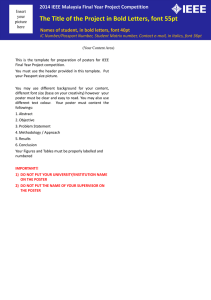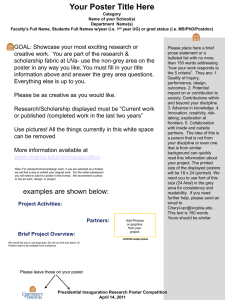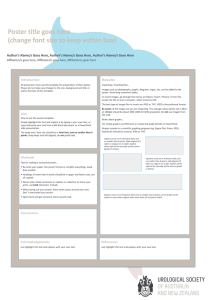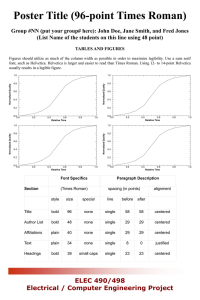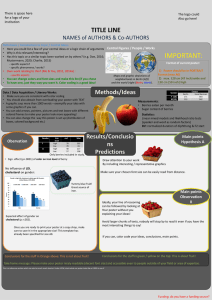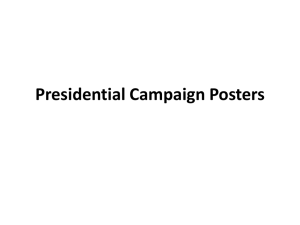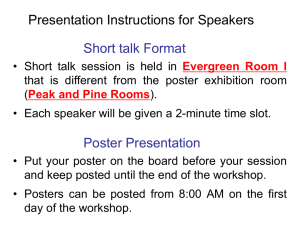Research Poster Template - College of Saint Benedict & Saint
advertisement
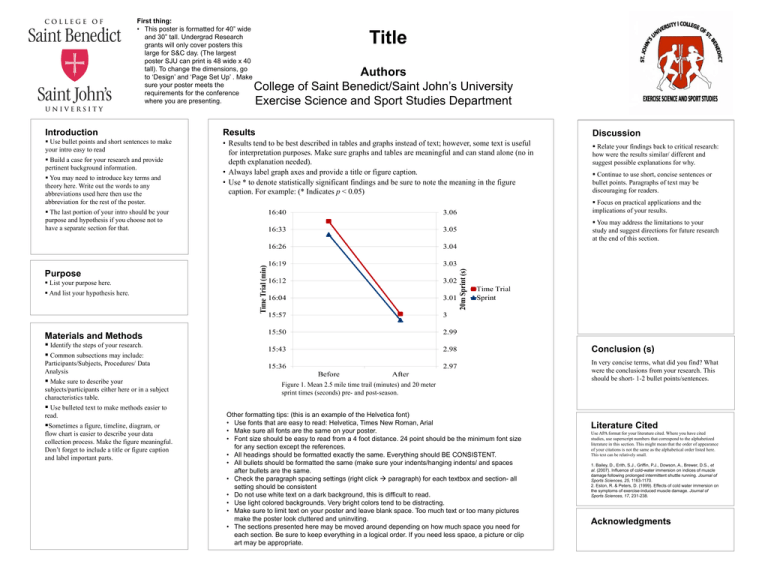
First thing: • This poster is formatted for 40” wide and 30” tall. Undergrad Research grants will only cover posters this large for S&C day. (The largest poster SJU can print is 48 wide x 40 tall). To change the dimensions, go to ‘Design’ and ‘Page Set Up’ . Make sure your poster meets the requirements for the conference where you are presenting. Title Authors College of Saint Benedict/Saint John’s University Exercise Science and Sport Studies Department Introduction Results Use bullet points and short sentences to make your intro easy to read • Results tend to be best described in tables and graphs instead of text; however, some text is useful for interpretation purposes. Make sure graphs and tables are meaningful and can stand alone (no in depth explanation needed). • Always label graph axes and provide a title or figure caption. • Use * to denote statistically significant findings and be sure to note the meaning in the figure caption. For example: (* Indicates p < 0.05) Build a case for your research and provide pertinent background information. You may need to introduce key terms and theory here. Write out the words to any abbreviations used here then use the abbreviation for the rest of the poster. Discussion Relate your findings back to critical research: how were the results similar/ different and suggest possible explanations for why. Continue to use short, concise sentences or bullet points. Paragraphs of text may be discouraging for readers. Focus on practical applications and the implications of your results. The last portion of your intro should be your purpose and hypothesis if you choose not to have a separate section for that. You may address the limitations to your study and suggest directions for future research at the end of this section. Purpose List your purpose here. And list your hypothesis here. Materials and Methods Identify the steps of your research. Common subsections may include: Conclusion (s) Participants/Subjects, Procedures/ Data Analysis In very concise terms, what did you find? What were the conclusions from your research. This should be short- 1-2 bullet points/sentences. Make sure to describe your subjects/participants either here or in a subject characteristics table. Figure 1. Mean 2.5 mile time trail (minutes) and 20 meter sprint times (seconds) pre- and post-season. Use bulleted text to make methods easier to read. Sometimes a figure, timeline, diagram, or flow chart is easier to describe your data collection process. Make the figure meaningful. Don’t forget to include a title or figure caption and label important parts. Other formatting tips: (this is an example of the Helvetica font) • Use fonts that are easy to read: Helvetica, Times New Roman, Arial • Make sure all fonts are the same on your poster. • Font size should be easy to read from a 4 foot distance. 24 point should be the minimum font size for any section except the references. • All headings should be formatted exactly the same. Everything should BE CONSISTENT. • All bullets should be formatted the same (make sure your indents/hanging indents/ and spaces after bullets are the same. • Check the paragraph spacing settings (right click paragraph) for each textbox and section- all setting should be consistent • Do not use white text on a dark background, this is difficult to read. • Use light colored backgrounds. Very bright colors tend to be distracting. • Make sure to limit text on your poster and leave blank space. Too much text or too many pictures make the poster look cluttered and uninviting. • The sections presented here may be moved around depending on how much space you need for each section. Be sure to keep everything in a logical order. If you need less space, a picture or clip art may be appropriate. Literature Cited Use APA format for your literature cited. Where you have cited studies, use superscript numbers that correspond to the alphabetized literature in this section. This might mean that the order of appearance of your citations is not the same as the alphabetical order listed here. This text can be relatively small. 1. Bailey, D., Erith, S.J., Griffin, P.J., Dowson, A., Brewer, D.S., et al. (2007). Influence of cold-water immersion on indices of muscle damage following prolonged intermittent shuttle running. Journal of Sports Sciences, 25, 1163-1170. 2. Eston, R. & Peters, D. (1999). Effects of cold water immersion on the symptoms of exercise-induced muscle damage. Journal of Sports Sciences, 17, 231-238. Acknowledgments


